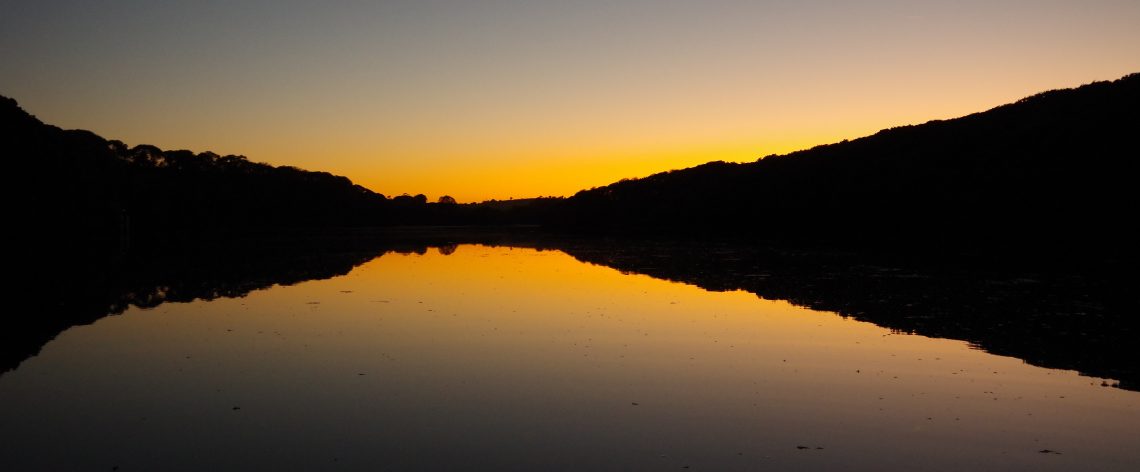The third (and final) version of my Pathfinder – the expedition boat.
What do we mean when using the term – expedition boat ?
Taking a look at some actual expedition boats and their owner/skippper.
Right now (May 2024) I have taken a big step backwards with my Pathfinder project, mainly because of my recent stroke, and I am using this time to treat the boat as a longer term project in which I convert it from sailaway mode to what I would think of as full-on expedition boat mode. The main things that are going in at the moment are the several ongoing projects : 1. It’s electrical system. 2. the rig rebuild and 3. the covers/shelter project.
As I said recently I seem to have difficulty managing multiple projects at once so, right now, the electrics project is on the backburner with the completion and closure of the battery compartment and the boat itself is back out from under the shelter so that I can use the dry space for working on the rig : I spent several tiring hours yesterday moving everything around again only this time using the car to push and pull the boat rather than using wedges and tayckles.

Expedition boat ?
To explain this concept as best I can I will refer mostly to other people’s boats and their voyages, and then how those boats, skippers and voyages inspired my own. If you’re saying, right now, ‘how can a 17 foot boat be an expedition boat’ ? then our first port of reference would be the excellent Howard Rice and his even smaller expedition boat Southern Cross – if you haven’t heard of either Howard or Southern cross then the boat is a modified John Welsford SCAMP design…..all of 12 feet in length and Howard was one of the early adopters/builders of the design and is still involved with running build classes (in mainland Japan I think).
Howard’s expedition was in the form of a sailing expedition around the Beagle Channel in Tierra Del Fuego and he wrote that up in the now defunct small craft advisory magazine – I think still available as an online purchase. My time in that part of the world was in an old and tired ex Whitbread maxi yacht and even though I enjoyed the wildness of that part of the world I was glad to sail away with an intact boat and crew.
The things that I take from Southern Cross and Howard’s voyage are mostly what a small boat might be capable of in expert hands and secondly the high level of attention to small details that it all took. The one thing I always wondered about is how difficult it would be to carry adequate water,fuel and stores in such a small space – the nearest I have got to that problem so far was with my lightweight centerboard cat ketch and even that was a much larger and heavier than the little SCAMP.
Howard’s boat – Southern Cross

Perhaps, the best way to start thinking about this,and, while we at it to decide what we mean by ‘expedition’ – to me it suggests going into a place that might well be difficult and uncomfortable and where we need a high level of skill and self reliance – higher on the mindset and skillset than mere ‘stuff’ that most concern themselves with. All of the boats and their skippers that i’m going to feature in this piece have both in terms of skills and self reliance Another feature, for me at least, is that I can respect, even admire, what some skippers have done without in any wishing to do those things myself although what I can do and often have done is use some aspect of the owner/skipper’s boat set-up. At the moment I am working on my own would be expedition boat and the detail that I take from Southern Cross is Howard’s well designed and made shelter/cover.
Before getting into specific boats and their owners I thought it would be a bit of fun to do a recap on the various sailors and their boats that have somehow inspired my own boats. The place where that all begins is with my first serious cruising boat that I bought secondhand and then started on a 2 stage refit with the intention of it becoming my ocean going long term cruising boat. If you’re now asking ‘what’s the difference between a well set up cruising boat and an expedition boat’ then my answer is very little aside from simplicity, ruggedness and what the Pardey’s called ‘unstoppability’ as a sailing quality.
My first go at a rugged and ultimately simple ‘go anywhere’ cruising boat – the Chuck Paine designed Frances 26 (WABI 2)
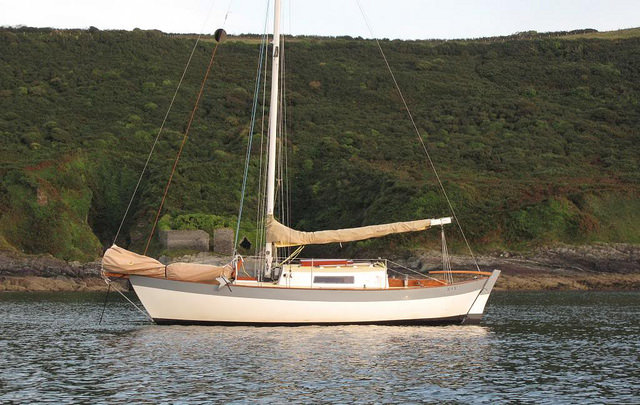
My Pardey inspired cruising boat was the 3 1/2 ton semi long keeled Frances 26 and in my opinion she was a great boat : she sailed well in all of the conditions that I experienced, for a ‘small’ 26 foot yacht she seemed to have more space than I actually needed and for my needs I found she could carry as much in way of water and stores as I ever needed – having said that I never took her transocean although I thought she was well capable of a transatlantic voyage.
Even considering the era when I bought and refitted the Frances I seemed to be going hard against the grain : I mainly sailed – even in very light weather, mostly I anchored out at a time when most boaters seemed to need to scuttle back to a marina at end of day. My systems were as simple as I could make them ; my sails were ‘up and down’ on hanks rather than expensive and unreliable roller reefing, I navigated mostly by log, compass, sextant and observation. With the little Frances I learnt most of what I know today about anchoring : she was the first boat that I regularly had to make a ‘Bahamian’ moor with. One of the most useful pieces of kit that I bought for the boat was an expensive Windpilot – wind driven self steering with which I did my channel crossings.
The only thing that I was never quite happy with was that she was still a relatively deep draught boat and towards the end of my time owning her I was developing a liking for shallow rivers and creeks – while I would happily lean the Frances against a wall to scrub and paint her bottom I never did get set up with a pair of drying-out legs.
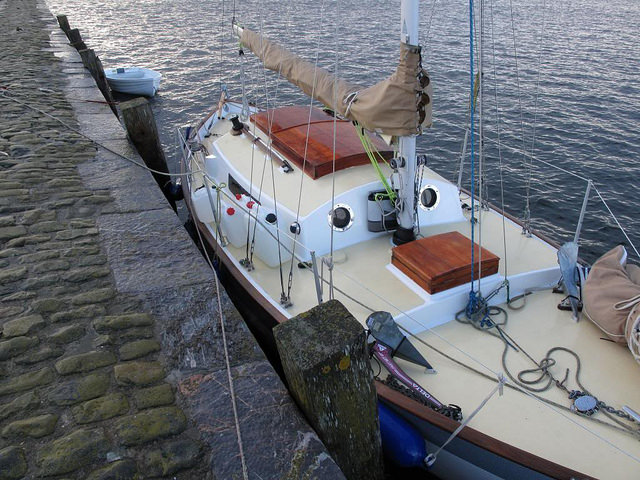
Having done offshore racing, oceans and blue water racing for most of my sailing life I got to the point where I wanted to do something completely different, one outcome is that I started to take an interest in very different ‘oddball’ kind of boats…..and I also started to think that i’d come into sailing about 30 or 40 years too late. Even at that time I felt that where I should be is up a muddy creek somewhere with a small boat rather than doing endless runs to France and back in charge of a watch on a maxi.
One mental change is that I started to adopt, as a sailor, a lot of the thinking from my previous existence as a climber/long distance ultralight style hiker. Where that took me was ultimately bushcraft and where it took me as a sailor was an interest in smaller, simpler and eventually backyard-built boats. I began to think that smaller is better and somewhere down that route were boats that would be as small and simple as I could get them – while still being able to cross the channel (English channel) but then once i’d got to the opposite side hide out in a shallow creek and dry out upright and level.
It’s obvious to me now that my idea of an expedition had changed from big boats and endless ocean to something a lot more intimate but still requiring skill,independence and self reliance.
Ruan creek inshore of Falmouth but it could easily be near the head of one of the tidal rivers in Brittany.
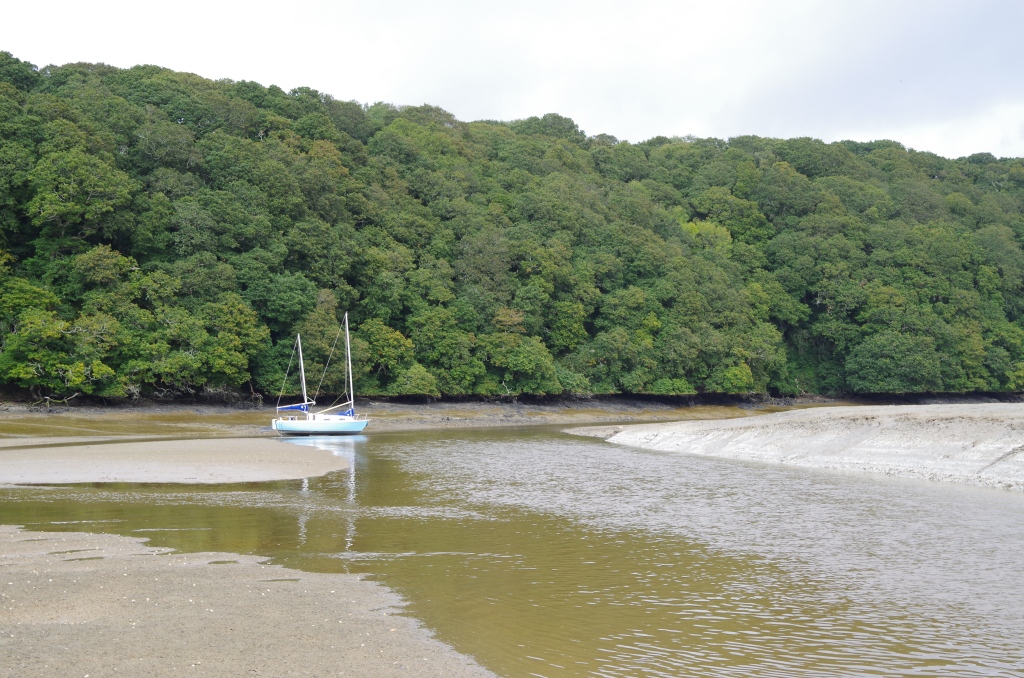
The arctic guy – Roger Taylor and Mingming
While the Pardey’s built their own boats from the keel up and sailed both of them several thousand miles they were still conventional designs with pretty standard rigs (apart from them being hanked sails). Not so with Englishman Roger Taylor who’s thing seemed to be undertaking long, solo cruises in Arctic waters, also in 2 boats over many years : what was unusual is that both of Roger’s boats he converted from standard small cruising yachts – first a 21 foot Corribee and second an Achilles 24. He gave both of them Junk rigs, both had bilge keels or in the case of the Achilles it came with a triple keel arrangement so either of them could dry out upright.
It’s purely a personal interpretation but that I think, in many ways, that Howard Rice and Roger Taylor had a similarity of desire – to go to difficult places, then had the same kind of problems to contend with and then both of them modified their boats extensively around solving those problems. Perhaps the things that I take from both of them is : 1. The personal value of choosing wild places rather than easy ‘hedonistic. cruising and 2. The high level of detail applied to make their voyages work.
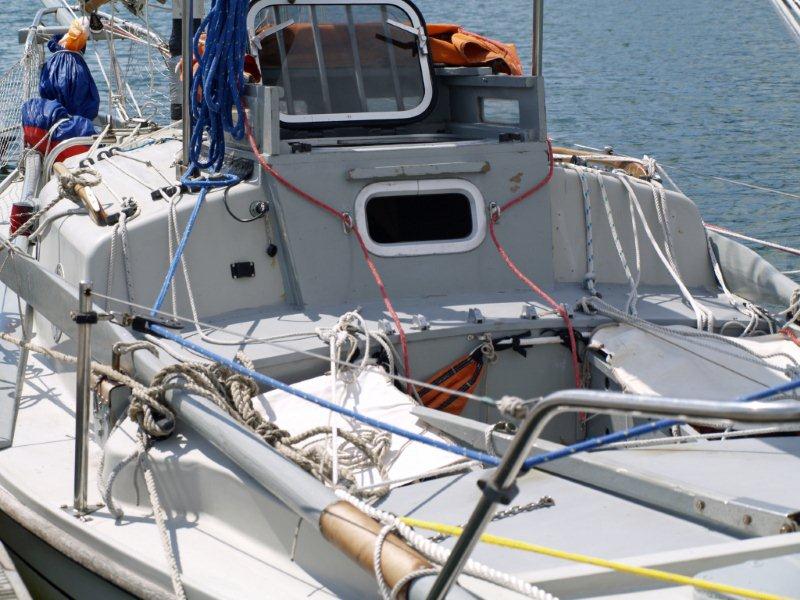
Other influences.
While the Pardey’s inspired 2 of my boats and both Rice and Taylor inspired my thinking about other boats – that was eventually what led me to buying the best boat I have ever owned it was other influences that eventually led me to building my own backyard expedition boat. The biggest influence, for me, wasn’t so much a single boat but multiple boats, many of them designed by the same bloke – John Welsford. The thing that linked them all was the influence of the Watertribe events such as the Everglades Challenge and, more distantly the non watertribe event : the race to Alaska. In a big way these smaller adventures seemed a lot more do-able to an ordinary guy and lots of people I think have benefited by pushing themselves a bit and having a crack at one or other – or both.
The Everglades Challenge became a kind of touchstone/benchmark for small and capable boats that could be built at home by someone of ordinary competence and then launched off a beach to take on a coastal cruise of some length – in the case of the EC some 300 miles.
The boat that probably inspired my build more than any other – an extended John Welsford Walkabout design.

The here and the now….
The last I heard of Howard Rice was a few years ago when he seemed to be running a SCAMP build course in Japan, iv’e not seen anything of Roger Taylor for years except that a video popped up a few weeks ago in which he hinted about building a new and smaller boat – he was a bit coy about what the design was and even who the designer is. Of the Pardeys, Larry died a few years back and I think Lin is still with us but retired.
4 years ago I started to build a John Welsford designed Pathfinder dinghy as my intended expedition/extended cruising boat for a sail and oar style voyage around England. Even before my stroke this year I was losing interest a bit although I am using the project as a kind of recovery exercise. A few weeks ago I decided to use this time to re rig the boat in the style that I originally intended – as a lug yawl. Yesterday, as I write I had a destruction derby kind of session as I stripped all the gear off my original mast and then spent an entire afternoon cutting out the compression post from the cuddy space. Today I spent most of the day building and shaping a mast step for the new rig and then shaping the old mast to hopefully go through the bore in the foredeck : some time this week we’ll make a trip up to the timber store and get some long lengths of builders timber to make a sheer-leg set up and I will have a go at getting the mast up and in.
For the first time in ages I feel a bit more positive about the boat because it is now, finally, becoming more as I originally intended. I’m working fast and focused to get to the point where the current project can slow down ; that will only be once I have measured up for the new sails…..the old unused mainsl is still attached to its spar and hanging up under the shelter. I like the way the almost empty space works up forward under the cuddy and I can well imagine sleeping under there once I get on with the next project….which I intend to be some form of cover/tent on the lines of Southern Cross.
There is still blood on the floor from when I lost my balance while climbing out of the boat – instead of stepping onto my step-up bench I managed to kick it away and gashed my shin as I lost control.
The compression post/girder comes out several hours after starting out !
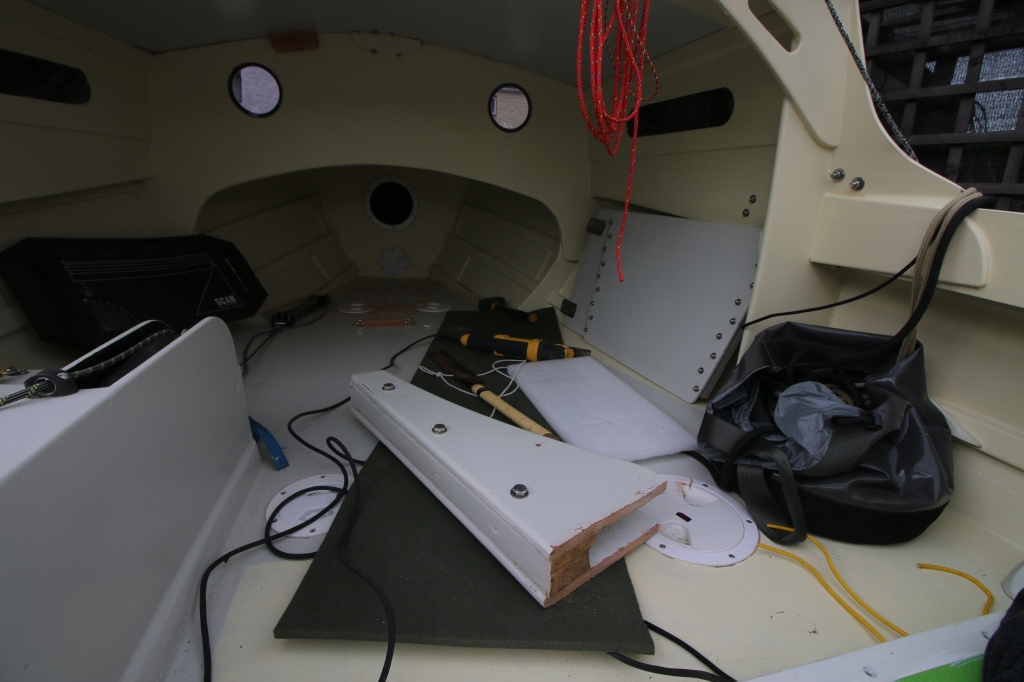
May 2024, post update. In the last few weeks we got a tantalizing hint and tease from Mr Arctic – Roger Taylor – and he was hinting that he’s building a new expedition boat based on sail and oar : naturally my thoughts went to some of John Welsford’s designs – especially Long Steps which is probably the ultimate sail and oar style small boat that can be built at home by a backyard boatbuilder. It turns out that what Roger is now building is one of the other boats that made it as far as my own shortlist – an Angus Rowcruiser – and i’m pretty sure that he’s building the full sailing version which is essentially a 1 man trimaran except that he has talked about using a junk rig : that seems like the wrong approach to me but he is the one with thousands of miles in junk rigged sailing yachts. I wish him well and I look forward to watching his progress although I can’t help but think that the Angus is what I would call a young man’s boat.
